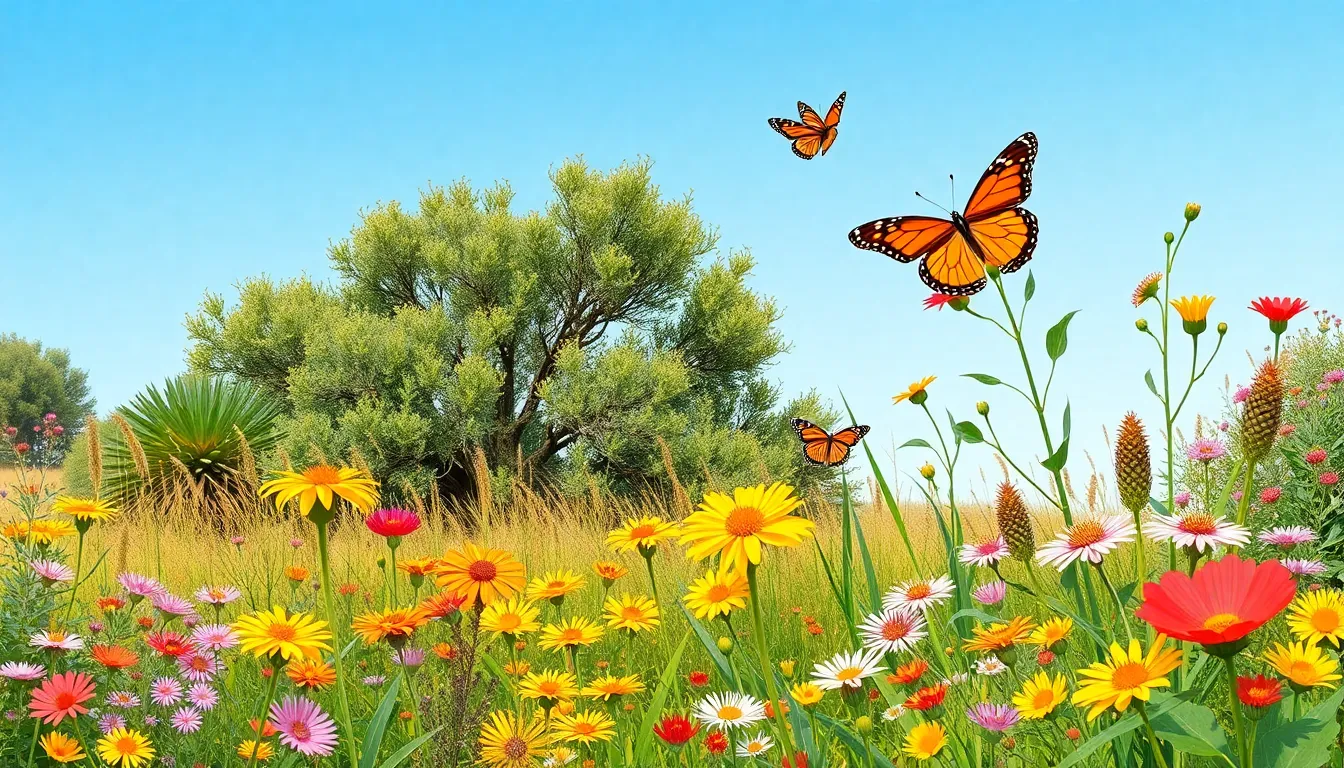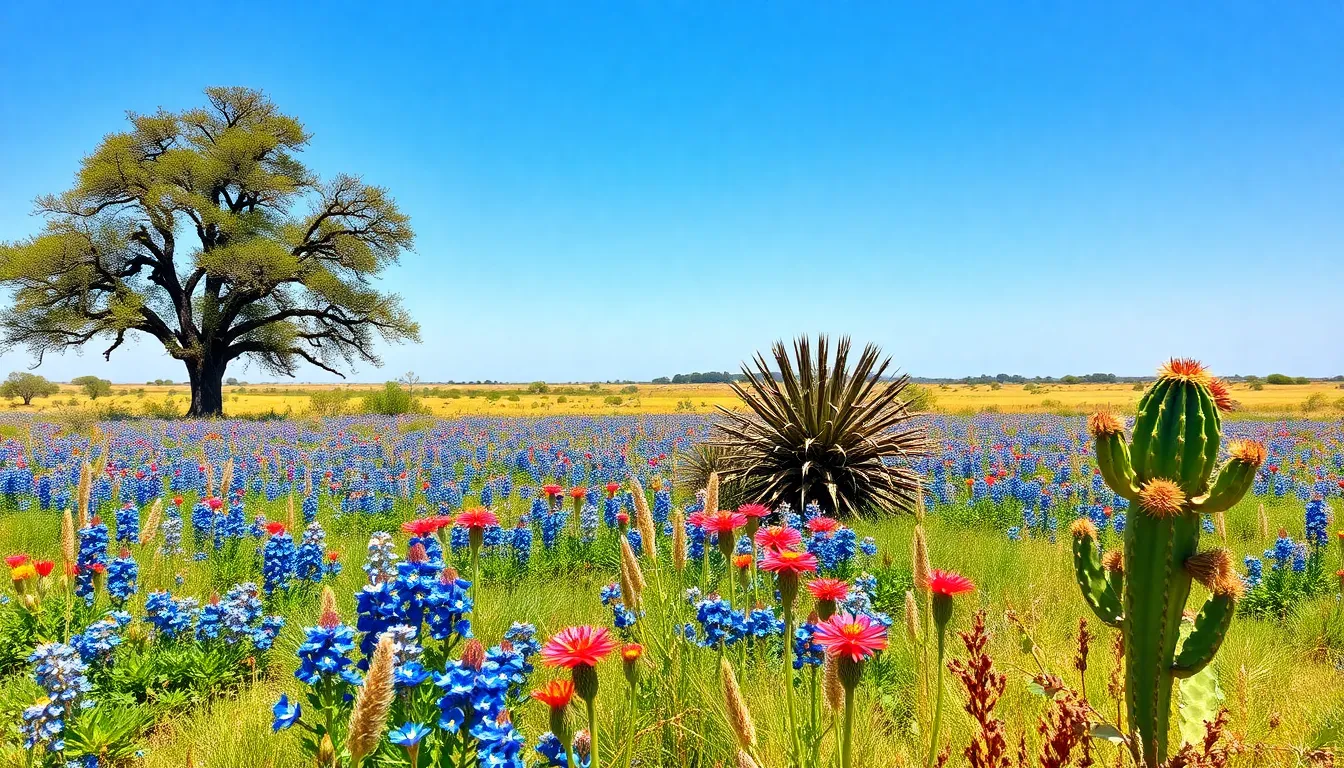Texas is famous for its vast landscapes and diverse ecosystems, but what really steals the show? The incredible plants that call this state home. From the prickly pear cactus to the vibrant bluebonnet, these native flora not only add beauty to the Lone Star State but also play a crucial role in its environment.
Plants Native to Texas
Texas showcases a wide array of native plants that thrive in its various climates and terrains. Bluebonnets symbolize the state, creating stunning displays in spring with their vibrant blue flowers. Prickly pear cacti grow abundantly in many regions, providing not only beauty but also sustenance for wildlife.
Wildflowers play a vital role in Texas ecosystems. Indian paintbrushes join bluebonnets, adding splashes of red and orange to the landscape. These plants attract pollinators like bees and butterflies, promoting biodiversity.
Trees, such as mesquite and live oak, dominate many landscapes. Mesquite trees offer shade and habitat for numerous species, while live oaks produce acorns that serve as food for birds and mammals. Both contribute to the ecological balance in their environments.
Grasses also represent a significant part of Texas flora. Buffalograss and blue grama thrive in prairies and savannas, providing essential ground cover. These grasses prevent soil erosion and support a diverse range of herbivores.
Cultivating native plants supports conservation efforts. Local gardens often incorporate these species to enhance landscaping while simultaneously protecting the environment. Homeowners and landscapers benefit from selecting native plants due to their low maintenance needs and resilience.
Texas’s native plants adapt well to varying conditions, reflecting the state’s climate diversity. They play essential roles in maintaining ecosystems while offering aesthetic value. Understanding and appreciating these plants contributes to a deeper connection with Texas’s natural heritage.
Importance of Native Plants

Native plants play a crucial role in maintaining Texas’s ecosystems, providing numerous benefits that extend beyond aesthetics.
Environmental Benefits
Native plants enhance biodiversity by serving as food sources and habitats for various wildlife species. They attract pollinators like bees and butterflies, essential for the reproduction of many flowering plants. Reduced water usage occurs since native plants are adapted to local climates, making them drought-resistant. Soil becomes healthier thanks to their deep root systems, which prevent erosion and improve nutrient cycling. Additionally, these plants support pest control by hosting natural predators, reducing the need for chemical pesticides. Promoting native flora directly contributes to ecosystem stability, fostering resilience against climate change.
Economic Impact
Native plants significantly affect Texas’s economy, particularly through ecotourism and agriculture. Tourists flock to see wildflower displays, contributing to local economies. Farmers benefit from using native crops that require less irrigation and maintenance, resulting in lower production costs. Nurseries specializing in native species boost local employment and merge with conservation efforts. Land management practices that incorporate native plants often enhance property value due to their environmental benefits. Overall, prioritizing native plants leads to sustainable economic growth while preserving Texas’s natural heritage.
Common Plants Native to Texas
Texas boasts a variety of native plants that thrive across its diverse landscapes. Each group has unique characteristics and benefits.
Trees
Mesquite trees, commonly found in Texas, adapt well to arid conditions, providing shade and shelter for wildlife. Live oak trees flourish in various regions, showcasing their broad canopies, which offer habitat for numerous species. Another notable tree is the pecan, valued for its edible nuts and significant in Texas agriculture. Cedar elm, resilient to drought and disease, enhances urban landscapes while contributing to local ecosystems. These trees collectively offer environmental benefits such as carbon sequestration and soil stabilization.
Shrubs
Texas sage, known for its silvery foliage and vibrant blooms, attracts pollinators and enhances local gardens. Another popular shrub is the agarita, which produces berries enjoyed by wildlife and humans alike. Indigobush serves as an attractive option for landscaping, with its vibrant spring display. Lantana thrives in Texas gardens, creating a colorful habitat for butterflies while requiring minimal water. These shrubs contribute to biodiversity, providing essential food sources and shelter for various animals.
Wildflowers
Bluebonnets stand out as Texas’s state flower, offering stunning displays each spring, drawing tourists from around the country. Indian paintbrushes add vibrant red and orange hues to the landscape, playing a vital role in attracting bees and other pollinators. Additionally, coreopsis blooms throughout the summer, providing continuous color and resilience in garden settings. Blanket flowers thrive in well-drained soils, promoting nectar availability for pollinators. These wildflowers support healthy ecosystems while enhancing Texas’s natural beauty.
Gardening with Native Plants
Gardening with native plants contributes to sustainable landscapes while supporting local ecosystems. Selecting suitable native plants ensures a thriving garden that reflects Texas’s natural beauty.
Choosing the Right Plants
Consider climate zones when selecting plants. The right choices ensure resilience against Texas’s varying weather patterns. Include iconic species such as bluebonnets, which attract pollinators and bloom vibrantly in spring. Explore trees like live oaks and mesquite that provide shade while supporting local wildlife. Adding shrubs like Texas sage enhances beauty and draws important insects. Additionally, native grasses like buffalograss play a vital role in preventing soil erosion. Prioritizing regional species creates a garden that thrives naturally in Texas’s diverse environments.
Care and Maintenance
Native plants typically require less maintenance compared to non-native varieties. Watering becomes essential primarily during establishment; established plants thrive on rainfall alone. Fertilization is often unnecessary as native plants are adapted to local soil conditions. Regular mulching helps retain moisture and suppress weeds effectively. Monitoring for pests can reduce the need for chemical interventions, as many native plants support natural pest management. Pruning encourages healthy growth but usually needs minimal intervention. Overall, maintaining a native garden promotes sustainability while reducing labor for gardeners.
Conservation of Native Species
Conservation of native species relies on protecting Texas’s unique plant diversity. This approach enhances local ecosystems, supports wildlife, and fosters community engagement. Legislative measures and public programs aim to safeguard native flora, promoting restoration and responsible land management practices.
Native plants thrive in Texas climates by adapting to specific environmental conditions. Soil health significantly improves through the deep-root systems of these species, which prevent erosion and reduce water runoff. Wildlife benefits from habitats provided by native vegetation, which serves as food sources for numerous organisms.
Organizations dedicated to conservation efforts advocate for the use of native plants in landscaping. Local nurseries that specialize in native flora supply gardeners with resilient species capable of flourishing without excessive care. Maintaining these plants contributes to a balanced ecosystem filled with biodiversity.
Public awareness initiatives play a crucial role in conservation. Educational programs inform residents about the ecological benefits of native plants, helping to cultivate appreciation for Texas’s natural heritage. Workshops teach proper gardening techniques, ensuring that the public can effectively implement native landscaping.
Collaborations between government agencies and conservation groups further strengthen efforts to protect native species. These partnerships facilitate habitat restoration projects and create more sustainable land usage. Testing new strategies for conserving native flora continues to be a priority for scientists and policymakers.
Sustaining Texas’s native plants ensures that future generations experience the state’s rich natural landscapes. Additionally, focusing on education and community involvement helps foster a culture of stewardship toward local ecosystems. This collaborative effort makes a meaningful impact on the preservation of Texas’s unique biodiversity.
Conclusion
Texas’s native plants are more than just beautiful additions to the landscape. They play a vital role in maintaining the state’s diverse ecosystems and supporting local wildlife. By choosing to cultivate these resilient species, individuals not only enhance their gardens but also contribute to environmental conservation.
Supporting native flora fosters biodiversity and promotes sustainable practices that benefit both the ecosystem and local economies. As awareness grows about the importance of these plants, communities can unite to protect and celebrate Texas’s unique botanical heritage for generations to come. Embracing native plants is a step toward a healthier environment and a deeper connection to the natural beauty of Texas.

